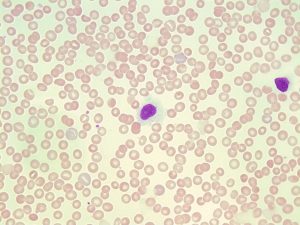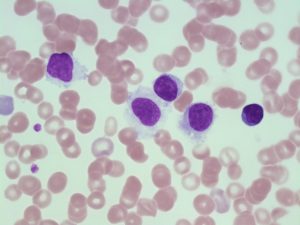13.3: Leucemia de células pilosas (HCL)
- Page ID
- 123256
\( \newcommand{\vecs}[1]{\overset { \scriptstyle \rightharpoonup} {\mathbf{#1}} } \)
\( \newcommand{\vecd}[1]{\overset{-\!-\!\rightharpoonup}{\vphantom{a}\smash {#1}}} \)
\( \newcommand{\id}{\mathrm{id}}\) \( \newcommand{\Span}{\mathrm{span}}\)
( \newcommand{\kernel}{\mathrm{null}\,}\) \( \newcommand{\range}{\mathrm{range}\,}\)
\( \newcommand{\RealPart}{\mathrm{Re}}\) \( \newcommand{\ImaginaryPart}{\mathrm{Im}}\)
\( \newcommand{\Argument}{\mathrm{Arg}}\) \( \newcommand{\norm}[1]{\| #1 \|}\)
\( \newcommand{\inner}[2]{\langle #1, #2 \rangle}\)
\( \newcommand{\Span}{\mathrm{span}}\)
\( \newcommand{\id}{\mathrm{id}}\)
\( \newcommand{\Span}{\mathrm{span}}\)
\( \newcommand{\kernel}{\mathrm{null}\,}\)
\( \newcommand{\range}{\mathrm{range}\,}\)
\( \newcommand{\RealPart}{\mathrm{Re}}\)
\( \newcommand{\ImaginaryPart}{\mathrm{Im}}\)
\( \newcommand{\Argument}{\mathrm{Arg}}\)
\( \newcommand{\norm}[1]{\| #1 \|}\)
\( \newcommand{\inner}[2]{\langle #1, #2 \rangle}\)
\( \newcommand{\Span}{\mathrm{span}}\) \( \newcommand{\AA}{\unicode[.8,0]{x212B}}\)
\( \newcommand{\vectorA}[1]{\vec{#1}} % arrow\)
\( \newcommand{\vectorAt}[1]{\vec{\text{#1}}} % arrow\)
\( \newcommand{\vectorB}[1]{\overset { \scriptstyle \rightharpoonup} {\mathbf{#1}} } \)
\( \newcommand{\vectorC}[1]{\textbf{#1}} \)
\( \newcommand{\vectorD}[1]{\overrightarrow{#1}} \)
\( \newcommand{\vectorDt}[1]{\overrightarrow{\text{#1}}} \)
\( \newcommand{\vectE}[1]{\overset{-\!-\!\rightharpoonup}{\vphantom{a}\smash{\mathbf {#1}}}} \)
\( \newcommand{\vecs}[1]{\overset { \scriptstyle \rightharpoonup} {\mathbf{#1}} } \)
\( \newcommand{\vecd}[1]{\overset{-\!-\!\rightharpoonup}{\vphantom{a}\smash {#1}}} \)
\(\newcommand{\avec}{\mathbf a}\) \(\newcommand{\bvec}{\mathbf b}\) \(\newcommand{\cvec}{\mathbf c}\) \(\newcommand{\dvec}{\mathbf d}\) \(\newcommand{\dtil}{\widetilde{\mathbf d}}\) \(\newcommand{\evec}{\mathbf e}\) \(\newcommand{\fvec}{\mathbf f}\) \(\newcommand{\nvec}{\mathbf n}\) \(\newcommand{\pvec}{\mathbf p}\) \(\newcommand{\qvec}{\mathbf q}\) \(\newcommand{\svec}{\mathbf s}\) \(\newcommand{\tvec}{\mathbf t}\) \(\newcommand{\uvec}{\mathbf u}\) \(\newcommand{\vvec}{\mathbf v}\) \(\newcommand{\wvec}{\mathbf w}\) \(\newcommand{\xvec}{\mathbf x}\) \(\newcommand{\yvec}{\mathbf y}\) \(\newcommand{\zvec}{\mathbf z}\) \(\newcommand{\rvec}{\mathbf r}\) \(\newcommand{\mvec}{\mathbf m}\) \(\newcommand{\zerovec}{\mathbf 0}\) \(\newcommand{\onevec}{\mathbf 1}\) \(\newcommand{\real}{\mathbb R}\) \(\newcommand{\twovec}[2]{\left[\begin{array}{r}#1 \\ #2 \end{array}\right]}\) \(\newcommand{\ctwovec}[2]{\left[\begin{array}{c}#1 \\ #2 \end{array}\right]}\) \(\newcommand{\threevec}[3]{\left[\begin{array}{r}#1 \\ #2 \\ #3 \end{array}\right]}\) \(\newcommand{\cthreevec}[3]{\left[\begin{array}{c}#1 \\ #2 \\ #3 \end{array}\right]}\) \(\newcommand{\fourvec}[4]{\left[\begin{array}{r}#1 \\ #2 \\ #3 \\ #4 \end{array}\right]}\) \(\newcommand{\cfourvec}[4]{\left[\begin{array}{c}#1 \\ #2 \\ #3 \\ #4 \end{array}\right]}\) \(\newcommand{\fivevec}[5]{\left[\begin{array}{r}#1 \\ #2 \\ #3 \\ #4 \\ #5 \\ \end{array}\right]}\) \(\newcommand{\cfivevec}[5]{\left[\begin{array}{c}#1 \\ #2 \\ #3 \\ #4 \\ #5 \\ \end{array}\right]}\) \(\newcommand{\mattwo}[4]{\left[\begin{array}{rr}#1 \amp #2 \\ #3 \amp #4 \\ \end{array}\right]}\) \(\newcommand{\laspan}[1]{\text{Span}\{#1\}}\) \(\newcommand{\bcal}{\cal B}\) \(\newcommand{\ccal}{\cal C}\) \(\newcommand{\scal}{\cal S}\) \(\newcommand{\wcal}{\cal W}\) \(\newcommand{\ecal}{\cal E}\) \(\newcommand{\coords}[2]{\left\{#1\right\}_{#2}}\) \(\newcommand{\gray}[1]{\color{gray}{#1}}\) \(\newcommand{\lgray}[1]{\color{lightgray}{#1}}\) \(\newcommand{\rank}{\operatorname{rank}}\) \(\newcommand{\row}{\text{Row}}\) \(\newcommand{\col}{\text{Col}}\) \(\renewcommand{\row}{\text{Row}}\) \(\newcommand{\nul}{\text{Nul}}\) \(\newcommand{\var}{\text{Var}}\) \(\newcommand{\corr}{\text{corr}}\) \(\newcommand{\len}[1]{\left|#1\right|}\) \(\newcommand{\bbar}{\overline{\bvec}}\) \(\newcommand{\bhat}{\widehat{\bvec}}\) \(\newcommand{\bperp}{\bvec^\perp}\) \(\newcommand{\xhat}{\widehat{\xvec}}\) \(\newcommand{\vhat}{\widehat{\vvec}}\) \(\newcommand{\uhat}{\widehat{\uvec}}\) \(\newcommand{\what}{\widehat{\wvec}}\) \(\newcommand{\Sighat}{\widehat{\Sigma}}\) \(\newcommand{\lt}{<}\) \(\newcommand{\gt}{>}\) \(\newcommand{\amp}{&}\) \(\definecolor{fillinmathshade}{gray}{0.9}\)- Imagen de un frotis de sangre periférica que demuestra dos células pilosas con abundante citoplasma azul pálido, pequeñas proyecciones citoplásmicas y núcleo de aspecto madurado dando a la célula un aspecto de “huevo frito”. Inmersión en aceite 50x. De la Colección MLS, Universidad de Alberta, https://doi.org/10.7939/R3ZG6GP2C
- Una imagen de un frotis de sangre periférica que demuestra las diferentes formas de células pilosas. Inmersión en aceite 100x. De la Colección MLS, Universidad de Alberta, https://doi.org/10.7939/R3610W71F
- Imagen de un frotis de sangre periférica que muestra una forma de célula pilosa con proyecciones citoplásmicas pilosas (izquierda) y una forma diferente de célula pilosa con abundante citoplasma azul pálido (derecha). Inmersión en aceite 50x. De la Colección MLS, Universidad de Alberta, https://doi.org/10.7939/R32805D72
Características de la celda: 1-4
Se pueden observar dos tipos de morfologías características de linfocitos B en la Leucemia de Células Peladas. Las células pilosas son células de tamaño pequeño a mediano con proyecciones citoplasmáticas dentadas que le dan un aspecto “peludo” o citoplasma azul pálido más abundante que le da un aspecto de “huevo frito”. El núcleo puede ser ovalado o indentado, carece de nucleolos y tiene un patrón de cromatina madura uniformemente teñido.
Causa: 1,5,6
Un trastorno de células B maduras clonales indolentes se ha asociado con la mutación BRAF -V600E.
Grupo de Edad Afectado: 2,6
Adultos de mediana edad (mediana de edad de 55 años).
Características de Laboratorio para HCL: 1,2,4,6
CBCD: Pancitopenia Linfocitosis relativa | Frotis de sangre periférica: Células peludas (± Apariencia de huevo frito) | Médula Ósea: Grifo Seco por fibrosis (Aspirado) Hipocelular |
Marcadores inmunológicos: CD19, CD20, CD22, CD25, CD123, Anexina A1 | Otras pruebas útiles: Tinción positiva con fosfatasa ácida resistente al tartrato (TRAP) |
|
Referencias:
1. Grever MR, Abdel-Wahab O, Andritsos LA, Banerji V, Barrientos J, Blachly JS, et al. Guías de consenso para el diagnóstico y manejo de pacientes con leucemia clásica de células pilosas. Sangre [Internet]. 2016 Feb 2 [citado 2018 Jun 22]; 129 (1) :553—61. Disponible en: http://www.bloodjournal.org/cgi/doi/10.1182/blood-2016-01-689422
2. Turgeon ML. Trastornos mieloides y monocíticos malignos y discrasias de células plasmáticas. En: Hematología clínica: teoría y procedimientos. 4ª ed. Filadelfia, PA: Lippincott Williams & Wilkins; 1999. p. 275-92.
3. Swerdlow SH, Campo E, Harris NL, Jaffe ES, Pileri SA, Stein H, et al. editores. OMS Clasificación de Tumores de Tejidos Hematopoyéticos y Linfoides Volumen 2. 4ª ed. Agencia Internacional para la Investigación del Cáncer (IARC); 2008.
4. Czader M. Neoplasias linfoides maduras. En: Aplicaciones y principios clínicos de hematología de Rodak. 5ta ed. San Luis, Misuri: Saunders; 2015. p. 619-41.
5. Troussard X, Cornet E. Leucemia de células pilosas 2018: Actualización sobre diagnóstico, estratificación de riesgo y tratamiento. Am J Hematol [Internet]. 2017 7 dic [citado 2018 Jun 25]; 92 (12) :1382—90. Disponible en: http://www.ncbi.nlm.nih.gov/pmc/articles/PMC5698705/
6. Jain P, Pemmaraju N, Ravandi F. Actualización sobre la biología y las opciones de tratamiento para la leucemia de células pilosas. Curr Treat Options Oncol [Internet]. 2014 jun [citado 2018 Jun 27]; 15 (2) :187—209. Disponible en: http://www.ncbi.nlm.nih.gov/pmc/articles/PMC4198068/





